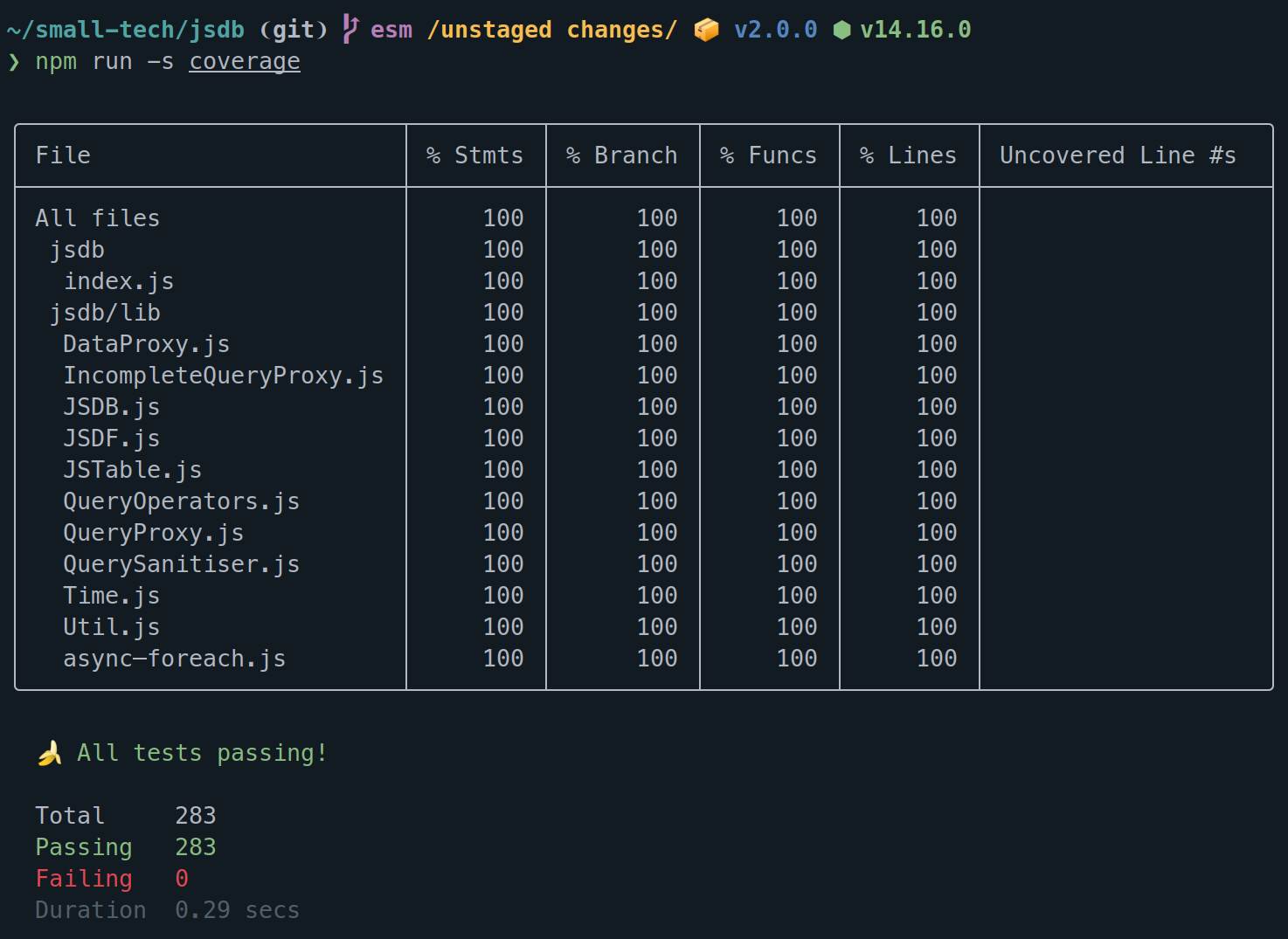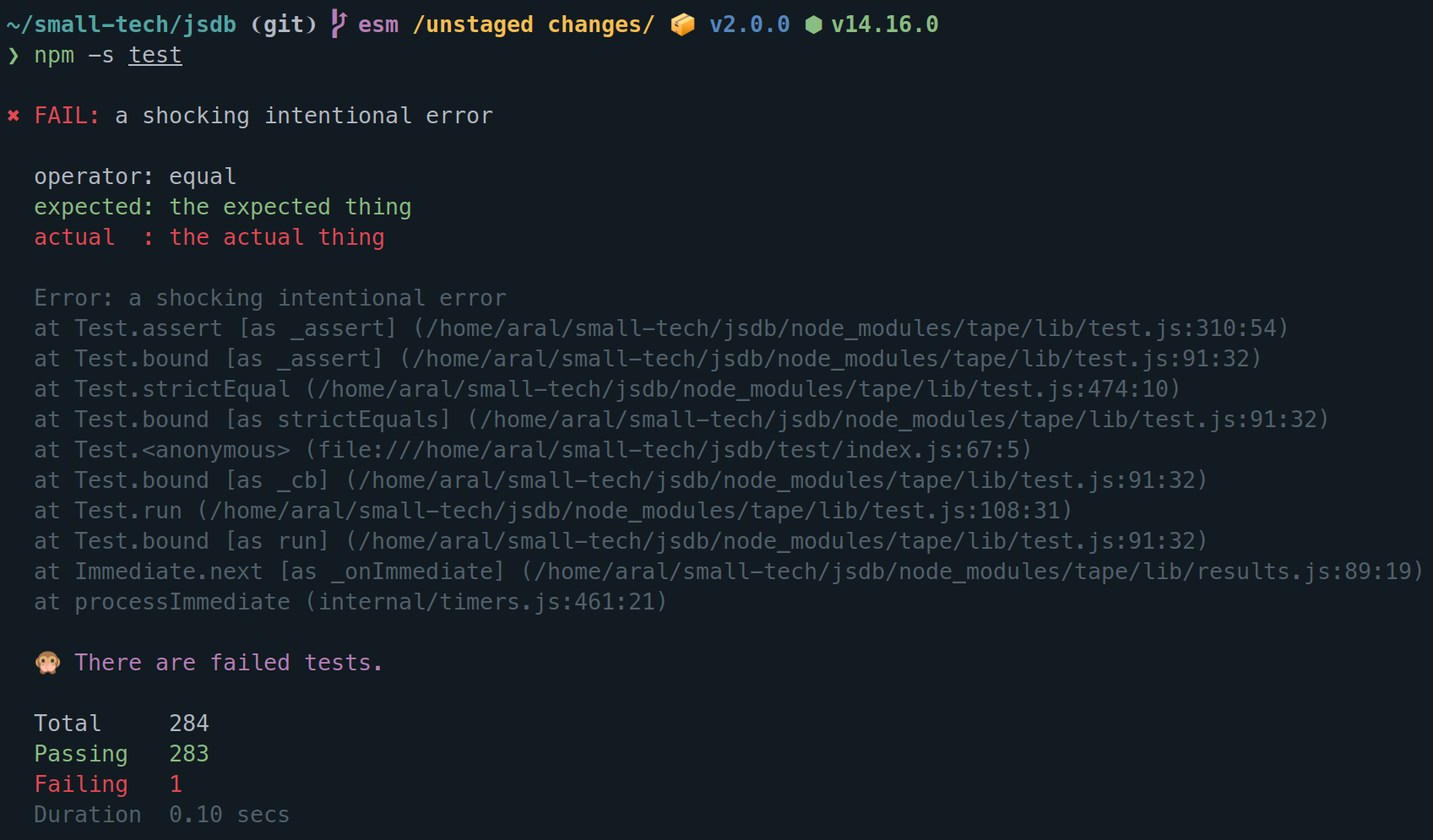@small-tech/tap-monkey
v1.4.0
Published
A tap formatter that’s also a monkey.
Downloads
59
Maintainers
Readme
Tap Monkey
🍌️🐒️

A tap formatter that’s also a monkey.
Displays test runner status using a static single-line spinner (hint: it’s a monkey) and only fills your screen with text on failures and with your coverage report.
Use it like tap-spec for running regular tests and also like tap-nyc for running coverage with c8 or nyc.
Install
npm i @small-tech/tap-monkeyUse
Pipe your tap test output to tap-monkey (e.g., if your test.js file contains tape tests):
node test.js | npx tap-monkeyOr, as a test task in your package.json file:
"scripts" : {
"test": "node test.js | tap-monkey"
}Or, if you have more than one test file:
"scripts" : {
"test": "tape test/**/*js | tap-monkey"
}Accessibility
For a quieter monkey, use the --quiet flag. e.g.,
"scripts" : {
"test": "tape test/**/*js | tap-monkey --quiet"
}When this flag is passed, only an initial notice is shown that tests are running and no further updates are given unless there are failures or until the final summary and/or coverage report are shown.
This is a general accessibility and usability feature. It might help folks using assistive devices like screen readers who might otherwise get overwhelmed by notifications of running/passing tests as well as anyone else who wants a generally calmer monkey.
Code coverage

Use Tap Monkey for code coverage in exactly the same way as you do for your tests.
e.g., using c8:
"scripts" : {
"coverage": "c8 tape test/**/*js | tap-monkey"
}Test failures

While passing tests are displayed ephemerally in the status line so as not to fill up your terminal window with unnecessary information, failed tests are always written in full to the terminal.
(When running tests, we don’t care about passing tests, only failing ones.)
Debug output
Any console output that is generated by your program (e.g., from console.log() statements) is displayed in full and separate from the current test status line.
This is useful while debugging. (I like to have regular and debug test tasks in my code and use the latter when debugging an issue encountered in a test.)
e.g., my regular tests define an environment variable that silences console output but I have a separate debug test task that doesn’t include this.
"scripts" : {
"test": "QUIET=true tape test/**/*js | tap-monkey",
"test-debug": "tape test/**/*js | tap-monkey"
}Then, all you need is to use a conditional log function in your app that checks for that environment variable. e.g.,
// Conditionally log to console.
export default function log (...args) {
if (process.env.QUIET) {
return
}
console.log(...args)
}Error behaviour
If your test runner (e.g., ESM Tape Runner) encounters an error in your app’s source code (e.g., a syntax error in one of your classes), it should bail out (and hopefully also log the error so you know what it is). Tap Monkey will respond to bail out events by displaying them and exiting (your test runner should have exit also so you should not get any pipe errors).
Testing Tap Monkey
Tap Monkey itself, of course, comes with unit tests displayed by none other than *drumroll* Tap Monkey!
Run tests
npm run -s testRun coverage
npm run -s coverageLike this? Fund us!
Small Technology Foundation is a tiny, independent not-for-profit.
We exist in part thanks to patronage by people like you. If you share our vision and want to support our work, please become a patron or donate to us today and help us continue to exist.
Copyright
© 2021 Aral Balkan, Small Technology Foundation.
License
ISC
